"Manual" air defense systems. Part of 4. MANPADS Robotsystem 70
In contrast to the portable air defense missile systems of the USA, the USSR and the UK, which were created at the same time, the Swedish complex can only be called a “portable” missile. The main disadvantage of the complex is called its large mass, two missiles in TPK and PU pull together on 120 kg. For the delivery of such a "portable" complex to the required place, it is necessary to use vehicles, or install it on different chassis. This was the conscious approach of the Swedes, which provided them with an advantage over foreign MANPADS of the same years in range and height of the targets and targets and the high potential for modernization of the complex. Adopted in 2001, the Bolide rocket significantly expanded the capabilities of MANPADS, which remains in service with various countries around the world.
Since the needs of ensuring the defense capability of Sweden were met by the military industrial complex of the country in abundance, in the 20th century almost every model of Swedish weapons was created with a view to export abroad, including for the Swedish partners in international military-political blocs. In this respect, the Robotsystem 70 MANPADS was no exception. Despite the fact that it was primarily developed for the Swedish armed forces, the corporate management of Bofors saw great potential in mastering the international arms market, including the US market. In the future, the complex is really actively promoted for export. From Russia's closest neighbors, it is in service with the armies of Latvia and Lithuania. These countries received RBS-70 MANPADS in the first half of the 2000's and are currently participating in a program to modernize them, purchasing new missiles, sights and equipment.
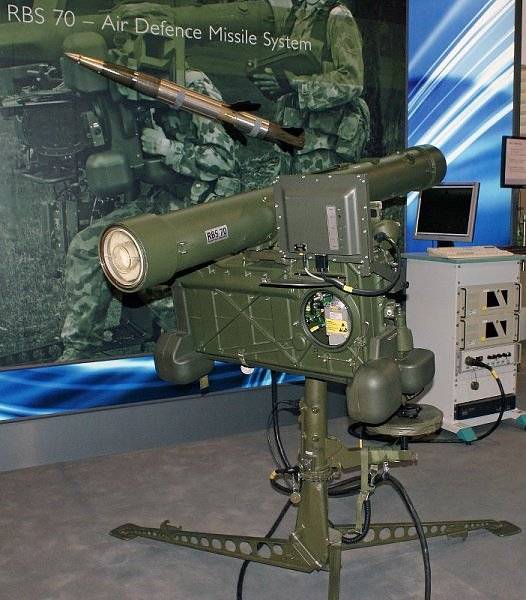
The creation of the Robotsystem 70 complex began in Sweden in 1967, and the first samples were put to the test through 7 years. In parallel with the fire part, work was done on the creation of the radio-technical part of the complex, in particular, the radar detection and targeting PS-70 / R. In 1977, the complex was adopted under the designation Robotsystem 70 (70 model missile system), abbreviated RBS-70. In the Swedish army, he occupied a niche between the 40-mm automatic artillery mounts L70 and the Hawk medium-range air defense systems. In the land forces of Sweden, it was intended to protect battalion-company units from air attack units.
The complex was initially created in accordance with such requirements of the Swedish Armed Forces as a long range of interception of air targets on a head-on course; high probability and accuracy of destruction; the ability to work on goals to the ground; resistance to all known natural and artificial disturbances; command control on the line of sight; possibility of further modernization, ensuring application at night. Based on the requirements of the military, the company Bofors Defense chose the option with guided anti-aircraft missiles at the target on the laser channel. Thus, the RBS-70 became the world's first MANPADS with a similar guidance system. From the very beginning of the design work, the complex was created with the prospect of installing it on a crawler and wheeled chassis, so that the designers were not strictly limited to the weight and dimensions of the complex. The first mobile version of the MANPADS was developed in the 1981 year on the basis of the Land Rover all-terrain vehicle, later on the RBS-70 was placed on a variety of chassis, including wheeled and tracked armored personnel carriers.
Work on the modernization of the complex Robotsystem 70 began almost immediately after its creation. So in 1990, the modernization of the Rb-70 SAM was presented, which received the designation Rb-70 Mk1. And already in 1993, a modification of the Rb-70 Mk2 rocket was adopted, which seriously improved the capabilities of MANPADS. The maximum target destruction range increased to 7000 meters, height - to 4000 meters, rocket speed - to 580 m / s. Appeared in 2001 year, the new Bolide missile system has further expanded the capabilities of the complex to defeat various air targets. The firing range increased to 8000 meters, the height of the targets hit - to 5000 meters, the rocket speed exceeded 680 m / s. Also, since 1998, in Sweden, work has been carried out on the modernization of all elements of the complex with the introduction of a new data transmission standard for the organization of a single information space of the air defense system.
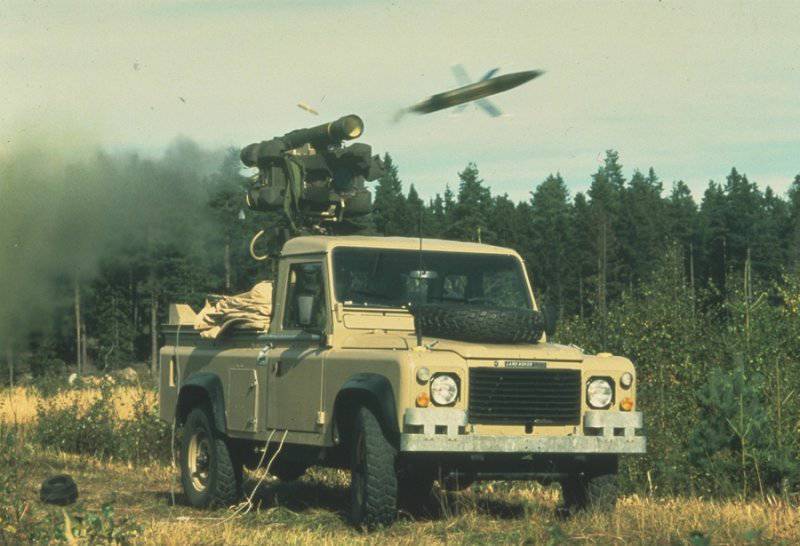
For all the time the production complex was assembled about 1500 launchers and more than 15 thousands of missiles of all modifications to them. According to data provided by Saab Bofors Dynamics, the total number of missile launches using RBS-70 MANPADS at the end of 2000 of the year was 1468, while more than 90 percent of the launched missiles hit targets.
At the moment of launch, the anti-aircraft missile-guided missile Rb-70 is ejected from the container at a speed of 50 m / s. After that, its marching solid propellant rocket motor turns on, which operates for 6 seconds, accelerating the missile defense to supersonic flight speed (about M = 1,6). The task of the operator of the complex is to keep the air target in the field of view of the stabilized sight. The laser beam emitted by the targeting unit forms a kind of “corridor”, in the center of which the rocket flies. The absence of radiation before the launch of the rocket and the low power used by MANPADS for targeting complicate the effective detection of RBS-70, and the command guidance of the rocket by the operator of the complex increases its noise immunity and makes it possible to confidently hit even air targets making energetic maneuvers.
Although each PU can be used independently, the main use case is the use of MANPADS complete with RS-70 Giraffe pulse Doppler radar operating in the 5,4-5,9 GHz band. This radar provides detection of a typical air target at a distance of up to 40 kilometers, the tracking distance is up to 20 kilometers. The antenna of the radar can be raised on a special mast to a height of 12 meters. In this case, the radar can be installed on different chassis. The deployment time of such a station is no more than five minutes. The radar calculation consists of 5 people who provide tracking of three air targets in manual mode and can serve up to 9 firing calculations.
Information on air targets is transmitted to the command and control console, from where it can be sent to specific launchers. The reaction time of MANPADS is 4-5 seconds. In this case, the operator of the RBS-70 complex receives information about the air target in the form of a sound signal in the headphones. When aiming at an air target, the radar automatically adjusts the accuracy of the MANPADS pointing by the operator, transmitting electrical impulses through the cable, which are converted by the speaker of the command and starting unit into sound signals of three different tonalities: 1) low tone signal - warns the operator of the complex about the deviation of the sight to the left air target; 2) high pitched signal - on the deviation of the sight to the right of the air target; 3) intermittent beep - an error in the determination by the operator of the complex of the true azimuth of the air target.
In 1982, the Swedish company Ericsson has created a portable radar for detecting and tracking targets, called HARD (Helicopter and Aircraft Radar Detection). This radar detection system is compact enough to be carried by one of the members of the crew, while transport is required for the transportation of the Giraffe radar. The instrumental range for detecting targets of this radar is 12 kilometers, it provides guaranteed detection of air targets and early warning of the MANPADS operator at a distance of 9 kilometers.
Anti-aircraft guided missile Rb-70 was designed according to the normal aerodynamic configuration and equipped with a two-stage solid propellant propulsion engine, which was located in the middle of the missile defense system. In the tail of the rocket is a laser receiver. And in the nose is a warhead, the undermining of which can be done using a contact or laser proximity fuse. After the explosion, the air target is hit by a shaped charge (armor penetration up to 200 mm) and finished spherical striking elements made of tungsten with a diameter of about 3 mm. Over time, the number of such damaging elements increased to three thousand. During the modernization of the rocket, which received more advanced large-sized main engines and warheads, thanks to the miniaturization of electronic elements, the dimensions and mass of the rocket remained almost unchanged. So the Rb-70 Mk2 1993 of the year and the Rb-70 Mk0 1977 of the year have the same length - 1,32 m. The Rb-70 rocket is placed in the transport and launch container, after launching the TLC is not reused.
The probability of hitting air targets using the Rb-70 Mk2 rocket is estimated at 0,7-0,9 when firing on a heading course and in 0,4-0,5 when firing at a follower course. At the same time, the process of modernization of the missiles lasted a long time. In 2002, the mass production of Bolide missiles for RBS-70 MANPADS began, which is a deep modernization of the Rb-70 Mk0, Mk1 and Mk2 missiles and is intended for use with existing PUs. The purpose of creating a new missile defense system was to increase the capabilities of the complex to combat vigorously maneuvering and unobtrusive targets, for example, cruise missiles.
The launcher of the portable anti-aircraft missile system RBS-70 included:
- anti-aircraft missile in TPC (weight 24 kg);
- guidance unit (mass 35 kg), consisting of a laser beam forming device with adjustable focusing and an optical sight (has 7-fold increase in the field of view 9 degrees);
- power supply and tripod (weight 24 kg);
- identification of “friend-foe” (mass 11 kg).
It is also possible to connect to the complex thermal imager COND, which provides the possibility of using MANPADS in the dark without sacrificing its main characteristics. This imager operates in the wavelength range from 8 to 12 μm and is equipped with a closed-cycle cooling system.
All elements of the Robotsystem 70 complex are located on a tripod, in the upper part of which there is a mounting unit for the guidance unit, as well as a container with an anti-aircraft missile, and in the lower part is an arrow-operator seat. The deployment time of the complex from the traveling position (from the wheels) to the combat position is 30 seconds. The calculation of the complex consists of two or three people. With three people, the complex becomes truly portable. A typical training course for an operator of Robotsystem 70 MANPADS using simulators in the Swedish Army 15-20 hours, which are usually distributed for 10-13 days.
The Swedish army also uses the self-propelled version of the RBS-70 complex - Type 701 (Lvrbv 701). Elements of the air defense system were placed on the chassis of the tracked Pbv302 armored personnel carrier. The transfer time of the complex from the marching position to the combat position is no more than a minute. Also, the RBS-70 complex has found wide application as a means of ship defense. As part of the Swedish Navy, it is included in the armament of the Stirso patrol boats and the M-80 type minesweepers. As a launcher, they use the same tripod as the land variant.
The complex Robotsystem 70 has pronounced advantages and disadvantages. In comparison with MANPADS equipped with IR / UV homing heads (“Igla”, “Stinger”, “Mistral”), the Swedish analogue significantly wins in firing range, especially on head-on courses. The ability to hit air targets outside the 4-5 range of kilometers allows the RBS-70 to bypass other MANPADS models. At the same time, the main drawback of the complex is its large mass. To move it, you need transportation, or installation on different chassis. At the same time, it cannot be used from the shoulder, carried or used in combat conditions to one person, which is also not always acceptable. At one time, this is precisely what led to the fact that the RBS-70 MANPADS lost the tender announced by South Africa.
The command method of targeting anti-aircraft guided missiles gives the Robotsystem 70 MANPADS characteristic features. Advantages include the ability to effectively combat low-flying targets and better noise immunity, and disadvantages include the vulnerability of complex calculations and high requirements for its preparation. The operator of the Swedish MANPADS needs to very quickly assess the speed of the air target, the range to it, the height and direction of flight, this information is necessary to launch the rocket. Accompanying the target takes up to 10-15 seconds, requiring the operator to take precise and fast actions in the conditions of high psycho-emotional stress of the combat situation. Also, the advantages of the complex include its relatively low cost, which was about half of the cost of the American Stinger MANPADS.
Tactical and technical characteristics of MANPADS Robotsystem 70 (1977 rocket of the year):
The range of targets hit - 5000 m.
The minimum range of targets hit is 200 m.
Target hit height - up to 3000 m.
Maximum rocket speed - 525 m / s.
Missile - Rb-70 Mk0
Rocket caliber - 106 mm.
Rocket length - 1,32 m.
Rocket launch weight - 15 kg.
The mass of the missile warhead - 1 kg.
The mass of the complex in the combat position (with a tripod, radar and the necessary equipment) - 87 kg.
The deployment time of the complex from the marching position to the combat position is 30 seconds.
Source:
http://rbase.new-factoria.ru/missile/wobb/rbs70/rbs70.shtml
http://nevskii-bastion.ru/complex-rbs-70
http://zonwar.ru/granatomet/pzrk/RBS-70.html
Open source materials
- Yuferev Sergey
- "Manual" air defense systems. Part of 1. MANPADS "Strela-2"
"Manual" air defense systems. Part of 2. MANPADS FIM-43 Redeye
"Manual" air defense systems. Part of 3. MANPADS Blowpipe

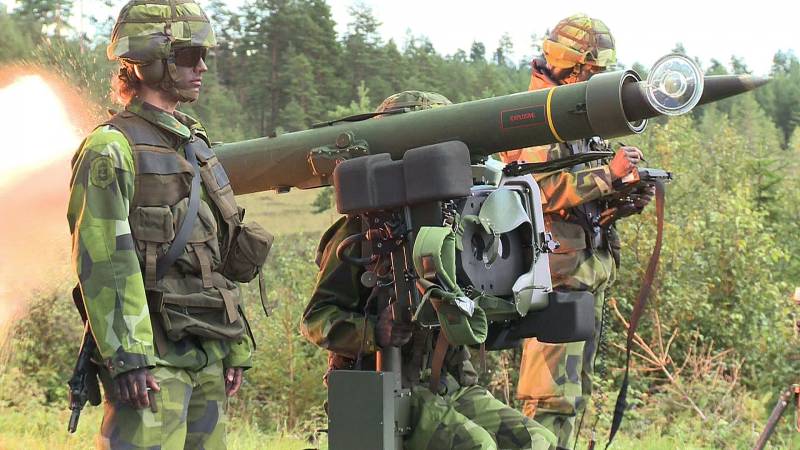
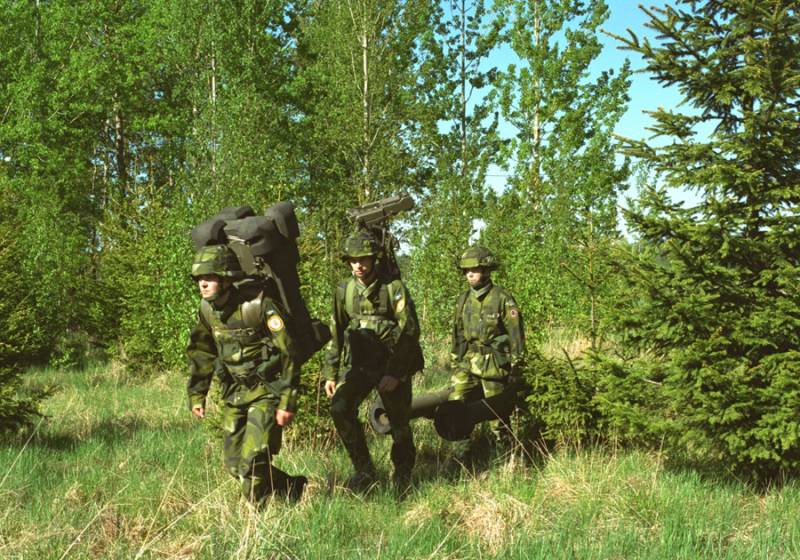
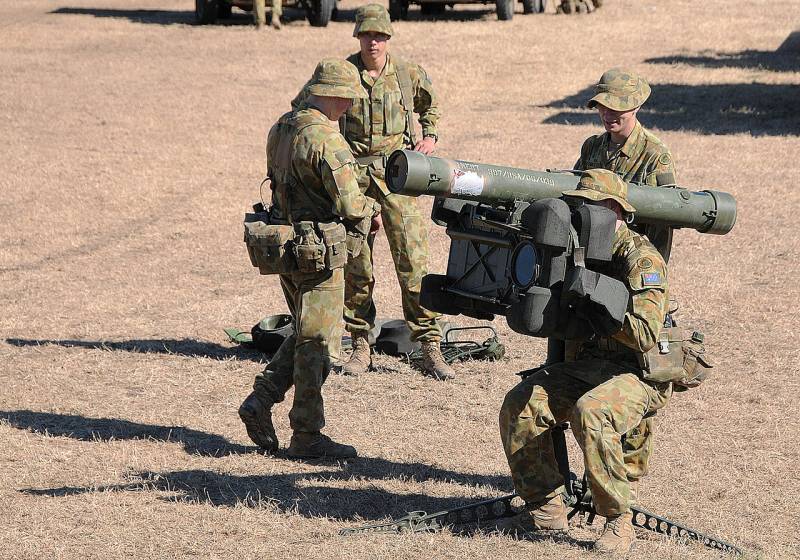
Information